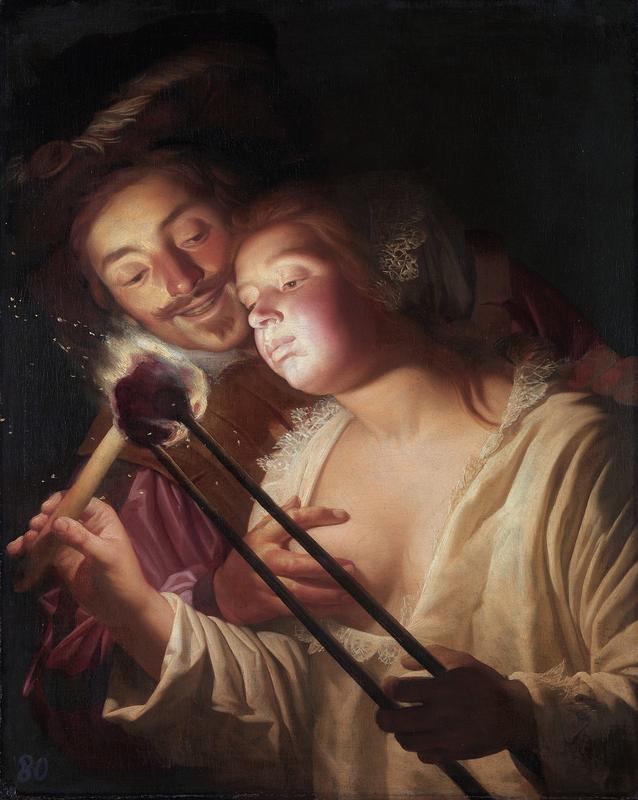More about The Soldier and the Girl

Sr. Contributor
When looking at The Soldier and the Girl, one might first think, another creepy old guy pawing at a young woman, which was a fairly common subject in 17th century Dutch art.
However, there’s just a bit more going on here. As one might guess, the young woman shown here is a prostitute, also another common subject for that time. In most paintings, but certainly not all, a woman in this profession was shown a little more subtly; this is pretty much in-your-face. I mean, just look at it.
This painting was completed after Honthorst’s return to Utrecht after a ten-year stay in Italy, where he became known for his many religious-themed paintings that showed his use of a single light source, sometimes a candle, in an otherwise fairly dark scene. In The Soldier and the Girl, Honthhorst shows the girl using a glowing coal to light a candle, which in this context symbolizes a couple of different things. The Herzog Anton Ulrich Museum claims this image serves as a “warning of the dangers of love, in particular of lust.” I guess that’s one way to put it; another way might be that things are about to heat up between the woman and the soldier.
It’s not surprising that Honthhorst would paint a prostitute, because he sure knew his way around a brothel. While in Rome, he had a (relatively) long-term relationship with one Vittoria da Rieti, a working girl he met in one of the city’s case di puttan (brothels). They also show up in some of his other works, such as The Procuress, Merry Company, and Smiling Girl, a Courtesan holding an Obscene Image. Prostitutes were often depicted as musicians in Dutch paintings of tavern or brothel scenes, and there was frequently an image of a procuress, usually shown as an ugly old woman, in most of these scenes, as well as plenty of food and drink to make the evening complete.
Surprisingly, or maybe not, paintings like these may have been pretty popular in the homes belonging to “respectable” people, and not just in some guy’s man cave. Keeping in mind that procuring, prostitution, and even adultery were illegal at this time, it’s hard to believe that these paintings were sold on the open market, and maybe they weren’t; they were likely commissioned by a wealthy patron to show off to his friends. It’s also been theorized that paintings such as these served as a kind of moral warning or lesson, but that’s probably a bit of a stretch; you wouldn’t find this painting hanging on the wall of a church.
Sources
- Adams, Ann Jensen. "Money and the Regulation of Desire: The Prostitute and the Marketplace in Seventeenth-Century Holland." In Renaissance Culture and the Everyday, edited by Fumerton Patricia and Hunt Simon, 229-53. University of Pennsylvania Press, 1999
- Ebert, Bernd, and Liesbeth M. Helmus. Utrecht, Caravaggio and Europe. Munich: Hirmer, 2018.
- Melion, Walter S., Joanna Woodall, and Michael Zell. Ut Pictura Amor: the Reflexive Imagery of Love in Artistic Theory and Practice, 1500-1700. Leiden: Brill, 2017.
- Honthorst, Gerard. “Der Soldat Und Das Mädchen.” Kulturerbe Niedersachsen. Accessed November 26, 2019. https://kulturerbe.niedersachsen.de/objekt/isil_DE-MUS-026819_opal_herz….
- “Gerrit Van Honthorst (Dutch, 1590 - 1656) (Getty Museum).” The J. Paul Getty in Los Angeles. Accessed November 16, 2019. http://www.getty.edu/art/collection/artists/541/gerrit-van-honthorst-du….
- “The Whore, the Bawd, and the Artist: The Reality and Imagery of Seventeenth-Century Dutch Prostitution.” Journal of Historians of Netherlandish Art. Accessed November 16, 2019. https://jhna.org/articles/whore-bawd-artist-reality-imagery-seventeenth…











